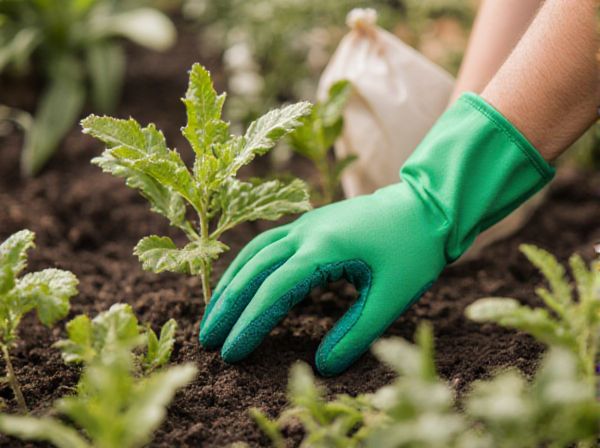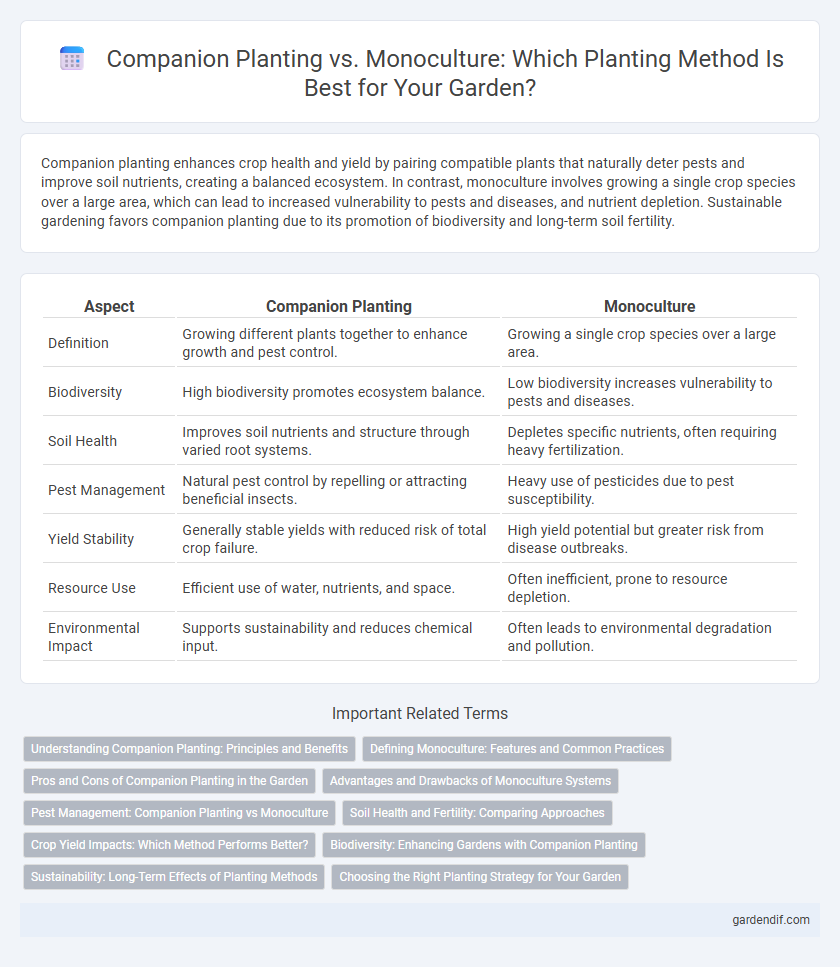
Companion Planting vs Monoculture Illustration
Companion planting enhances crop health and yield by pairing compatible plants that naturally deter pests and improve soil nutrients, creating a balanced ecosystem. In contrast, monoculture involves growing a single crop species over a large area, which can lead to increased vulnerability to pests and diseases, and nutrient depletion. Sustainable gardening favors companion planting due to its promotion of biodiversity and long-term soil fertility.
Table of Comparison
| Aspect | Companion Planting | Monoculture |
|---|---|---|
| Definition | Growing different plants together to enhance growth and pest control. | Growing a single crop species over a large area. |
| Biodiversity | High biodiversity promotes ecosystem balance. | Low biodiversity increases vulnerability to pests and diseases. |
| Soil Health | Improves soil nutrients and structure through varied root systems. | Depletes specific nutrients, often requiring heavy fertilization. |
| Pest Management | Natural pest control by repelling or attracting beneficial insects. | Heavy use of pesticides due to pest susceptibility. |
| Yield Stability | Generally stable yields with reduced risk of total crop failure. | High yield potential but greater risk from disease outbreaks. |
| Resource Use | Efficient use of water, nutrients, and space. | Often inefficient, prone to resource depletion. |
| Environmental Impact | Supports sustainability and reduces chemical input. | Often leads to environmental degradation and pollution. |
Understanding Companion Planting: Principles and Benefits
Companion planting involves strategically growing different plant species together to enhance growth, deter pests, and improve soil health through natural symbiotic relationships. This method increases biodiversity, which promotes pest control and reduces the need for chemical fertilizers and pesticides. Unlike monoculture, companion planting supports sustainable agriculture by fostering ecosystem balance and improving crop yield quality.
Defining Monoculture: Features and Common Practices
Monoculture refers to the agricultural practice of growing a single crop species in a specific area repeatedly, which often leads to uniformity in plant types and simplifies management but can increase vulnerability to pests and diseases. This method features large-scale planting, mechanized cultivation, and extensive use of chemical fertilizers and pesticides to maintain high yields. Common practices in monoculture include continuous cropping of staple plants like corn, wheat, or soybeans, prioritizing efficiency and maximizing short-term production over biodiversity.
Pros and Cons of Companion Planting in the Garden
Companion planting enhances biodiversity by pairing mutually beneficial plants, which can improve pest control, boost growth, and enhance soil health. It reduces the reliance on chemical pesticides and fertilizers, promoting a more sustainable and eco-friendly garden environment. However, it requires careful planning and knowledge of plant relationships, and improper combinations may lead to competition for nutrients and reduced yields.
Advantages and Drawbacks of Monoculture Systems
Monoculture systems enable large-scale crop production with streamlined management practices and mechanization, enhancing operational efficiency and consistency in yield. However, this approach increases vulnerability to pests, diseases, and soil depletion, often necessitating higher chemical inputs that can degrade environmental health. The lack of biodiversity in monoculture reduces ecological resilience and long-term sustainability compared to diversified companion planting strategies.
Pest Management: Companion Planting vs Monoculture
Companion planting enhances pest management by naturally repelling harmful insects and attracting beneficial predators, reducing the need for chemical pesticides. Monoculture systems often suffer from higher pest infestation due to uniform crops providing abundant food sources for specific pests. Integrating diverse plant species in companion planting creates a balanced ecosystem that disrupts pest life cycles and promotes healthy crop growth.
Soil Health and Fertility: Comparing Approaches
Companion planting enhances soil health by promoting biodiversity that improves nutrient cycling and reduces pest infestations, leading to balanced soil fertility. In contrast, monoculture depletes specific nutrients rapidly, increasing the need for chemical fertilizers and reducing microbial diversity. Sustainable soil management favors companion planting for maintaining long-term fertility and ecological resilience.
Crop Yield Impacts: Which Method Performs Better?
Companion planting enhances crop yield by promoting biodiversity, improving soil health, and reducing pest pressure through natural pest control and nutrient sharing among plants. Monoculture often results in higher short-term yields for specific crops but increases vulnerability to pests, diseases, and soil degradation, which can reduce long-term productivity. Studies show companion planting systems typically outperform monoculture in sustainable yield stability and resilience, especially in diverse agricultural environments.
Biodiversity: Enhancing Gardens with Companion Planting
Companion planting significantly boosts garden biodiversity by integrating multiple plant species that support each other's growth, pest resistance, and nutrient uptake. Unlike monoculture, which relies on a single crop and often depletes soil health, companion planting encourages a balanced ecosystem with pollinators and beneficial insects. This diversity improves resilience against pests and diseases while enhancing soil fertility and crop yields naturally.
Sustainability: Long-Term Effects of Planting Methods
Companion planting enhances soil health and biodiversity by promoting natural pest control and nutrient cycling, leading to more sustainable agricultural systems. In contrast, monoculture practices often deplete soil nutrients, increase vulnerability to pests and diseases, and require higher chemical inputs, undermining long-term sustainability. Sustainable farming benefits significantly from companion planting due to improved resilience and reduced environmental impact.
Choosing the Right Planting Strategy for Your Garden
Companion planting enhances garden biodiversity by pairing plants that improve each other's growth, pest resistance, and nutrient use, such as tomatoes with basil or beans with corn. Monoculture planting, while simpler to manage, can lead to soil depletion and increased vulnerability to pests and diseases due to lack of diversity. Selecting the right planting strategy depends on garden size, crop goals, and environmental conditions, with companion planting favored for sustainable, resilient ecosystems and monoculture suited for large-scale, uniform crop production.
Companion Planting vs Monoculture Infographic

 gardendif.com
gardendif.com